Business
Use Cases and Benefits of AI Analytics for Businesses
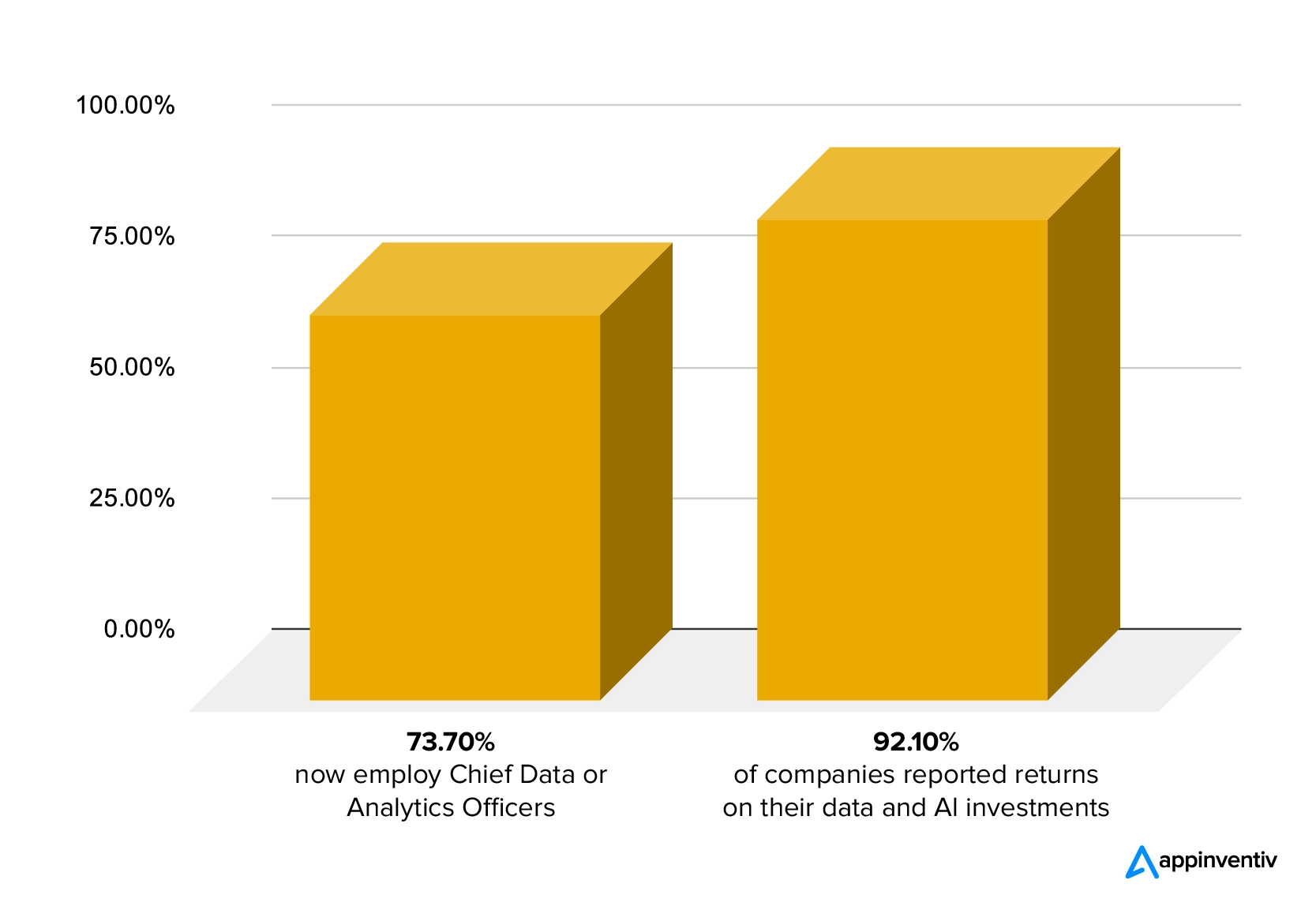
The implementation of AI is pervasive across all industries, bringing a shift in how businesses operate and innovate. Its applications range from cost reduction and error prevention to improved customer assistance, efficiency improvement, and routine task automation.
One significant advancement in this AI-driven expansion is the emergence of revolutionary technologies such as generative AI. This new frontier opens up new possibilities for data-driven decision-making in enterprises and expands the application of AI analytics. AI’s trajectory promises innovative solutions to complex problems as it continues to develop, highlighting its critical role in forming the modern business environment.
In this curated blog, we will study the need and importance of AI-based analytics for businesses, its benefits, use cases, and real-life examples of prominent brands. Let’s take a quick walkthrough.
The Importance of AI Analytics for Businesses
A survey by NVP reflects the strategic changes businesses have made to become data-driven organizations. These changes have included a move from data management to Big Data and, most recently, AI and analytics. Interestingly, 73.7% of companies now employ Chief Data or Analytics Officers, a notable increase from 12.0%, as recorded in 2012. The survey also indicates a noteworthy trend, with 92.1% of companies reporting returns on their data and AI investments in 2024, a significant rise from 48.1% in 2017.
Overall, this report sheds light on how businesses strategically use AI analytics to boost efficiency and innovation. AI analytics is critical to the contemporary business landscape since it revolutionizes decision-making and ensures operational effectiveness.
Businesses can obtain previously unattainable insights by using AI algorithms to examine large datasets, facilitating strategic planning and well-informed decision-making. By forecasting market trends, AI predictive analytics maximizes the use of available resources. AI-powered analytics improve risk assessment and individualized patient care in industries like finance and healthcare.
In addition to streamlining procedures, this revolutionary tool gives organizations the flexibility they need to adapt to a constantly changing marketplace. AI analytics can transform how businesses function, encourage innovation, and provide a competitive advantage in today’s fast-paced business environment.
Also Read: How Cloud Analytics Helps Businesses Make Data-Driven Decisions Faster
AI Analytics vs Traditional Data Analytics
AI analytics represents a transformative evolution beyond traditional data analytics methods. While both approaches aim to extract valuable insights from data, they differ significantly in their capabilities and methodologies. Here’s a quick comparison:
| Aspect | AI Analytics | Traditional Data Analytics |
|---|---|---|
| Data Type | Capable of handling both structured and unstructured data, providing a more thorough analysis | Ideal for structured searches and organized data |
| Methodology | Leverages machine learning algorithms, NLP, and deep learning for more dynamic and adaptive structured and unstructured data analysis | Mostly uses structured data analysis and pre-written queries |
| Insight Generation | Finds insights through real-time detection of intricate patterns, trends, and anomalies while adjusting to shifting data dynamics | Produces insights using predefined patterns and previous data |
| Human Involvement | Minimizes the need for human involvement, freeing analysts to concentrate on more complex decision-making duties | Requires a large amount of human intervention to formulate queries and analyze results |
| Flexibility | Incredibly flexible and capable of self-adjusting to changing trends and patterns in data | Restricted capacity to modify new data patterns manually |
| Use Cases | Enables forecasting and proactive decision-making by expanding to predictive and prescriptive analytics | Often used in diagnostic and descriptive analytics |
The above table highlights the key distinctions between advanced AI analytics and traditional data analytics. For a deeper exploration and understanding of the evolving landscape of data analytics, you can refer to our comprehensive guide on data analytics.
Benefits of AI Analytics for Business
Businesses can reap several benefits from AI analytics as it transforms decision-making processes and boosts overall operational effectiveness. Let’s check those out.
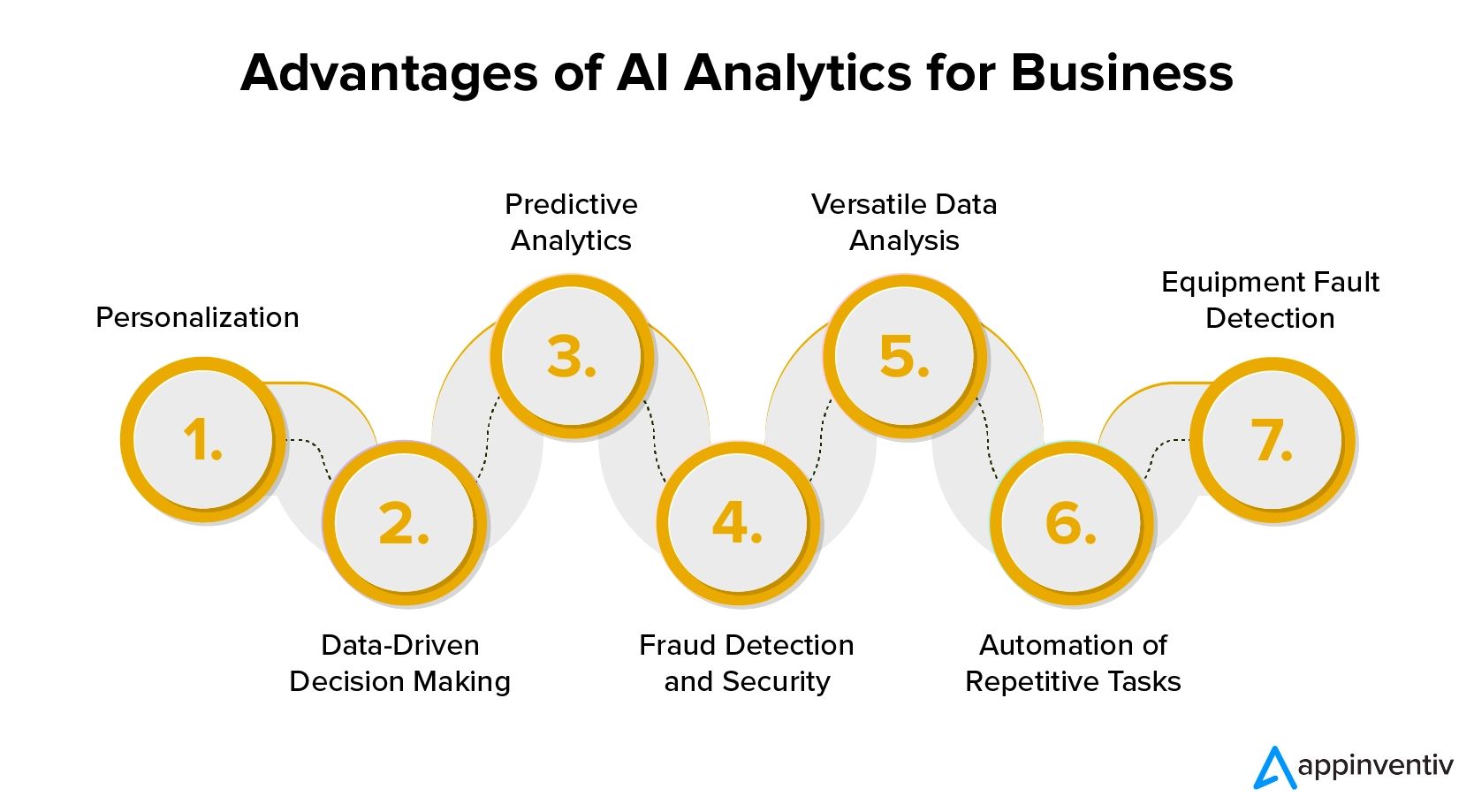
Personalization
AI analytics uses machine learning algorithms to react dynamically to changing customer preferences, going beyond simple analysis. AI analytics helps understand unique user behaviors by continuously extracting information from user interactions, enabling companies to provide hyper-personalized experiences.
The precise understanding obtained from AI data analytics facilitates the development of customized marketing strategies, guaranteeing that every customer engagement is pertinent and captivating. AI’s capacity to forecast consumer preferences solidifies its position as a driver for companies looking to surpass customer expectations in a market that is becoming more and more competitive.
Data-Driven Decision Making
AI analytics solutions can quickly scan large datasets and identify important patterns and connections that conventional statistical methods would miss. Its capacity to recognize complex data patterns enables companies to find untapped possibilities and possible challenges. Furthermore, the iterative nature of AI-powered analytics guarantees steady advancement in decision-making precision.
An agile and responsive business strategy, facilitated by adaptive learning, is crucial in navigating changing market dynamics. Ultimately, AI analytics’ speed, ability to identify patterns, and potential for ongoing improvement make it a vital tool for any organization looking to prosper in the data-driven business environment.
Predictive Analytics
AI’s predictive data analysis extends beyond the mere identification of market trends. It adopts a strategic approach to understand and optimize business operations comprehensively. AI in data analytics not only evaluates possible risks and opportunities but also anticipates changes in consumer behavior and industry trends by utilizing past data patterns.
Predictive analytics empowers businesses to take preventative action and mitigate potential risks. Moreover, AI systems’ flexibility allows them to improve projections, guaranteeing forecast accuracy in changing circumstances continuously. Being proactive improves strategic decision-making, allowing companies to remain ahead of the curve, seize new opportunities, and precisely handle challenges.
Fraud Detection and Security
Artificial intelligence analytics acts as a defender in the financial industry, using sophisticated algorithms to identify complex patterns indicative of fraudulent activity. Because of its real-time monitoring capabilities, transaction irregularities can be quickly identified, providing dynamic protection against ever-evolving cyber threats.
Leveraging AI in analytics can help identify fraud prevention strategies, increasing the resilience of security measures. This strengthens AI’s position as a vital ally in protecting the financial sector from cyber threats and fraudulent schemes.
Also Read: 10 Ways in Which AI is Revolutionizing the Financial Sector
Versatile Data Analysis
Artificial Intelligence in data analytics broadens its scope to include complicated and unstructured datasets. This flexibility allows businesses to extract insights from structured databases and sources like text, photos, and multimedia.
AI for data analytics offers a more comprehensive insight into operations, markets, and customer behavior by supporting various data formats. This adaptability is especially helpful in sectors where data is available in various formats, allowing for a more thorough and intricate approach to strategic planning and decision-making.
Equipment Fault Detection
Businesses are utilizing artificial intelligence’s capabilities to scan large datasets and identify trends for defect detection and predictive maintenance. By utilizing AI in data analytics, it becomes possible to predict machinery faults or maintenance needs by closely examining equipment sensors and previous data.
By utilizing AI for fault detection, businesses can seamlessly schedule maintenance, which minimizes costly downtime and maximizes operational efficiency. Predictive maintenance using AI improves equipment reliability and serves as a strategic asset for numerous sectors, guaranteeing efficient operations and economical maintenance procedures.
Also Read- How is AI in Business Bringing Transformation?
AI Analytics in Business – Use Cases and Real-Life Examples
AI analytics’s numerous uses are revolutionizing businesses in various industries. These use cases demonstrate the critical role of AI and data analytics in transforming processes and decisions in several business sectors. Let’s explore some real-life examples of AI analytics for businesses:
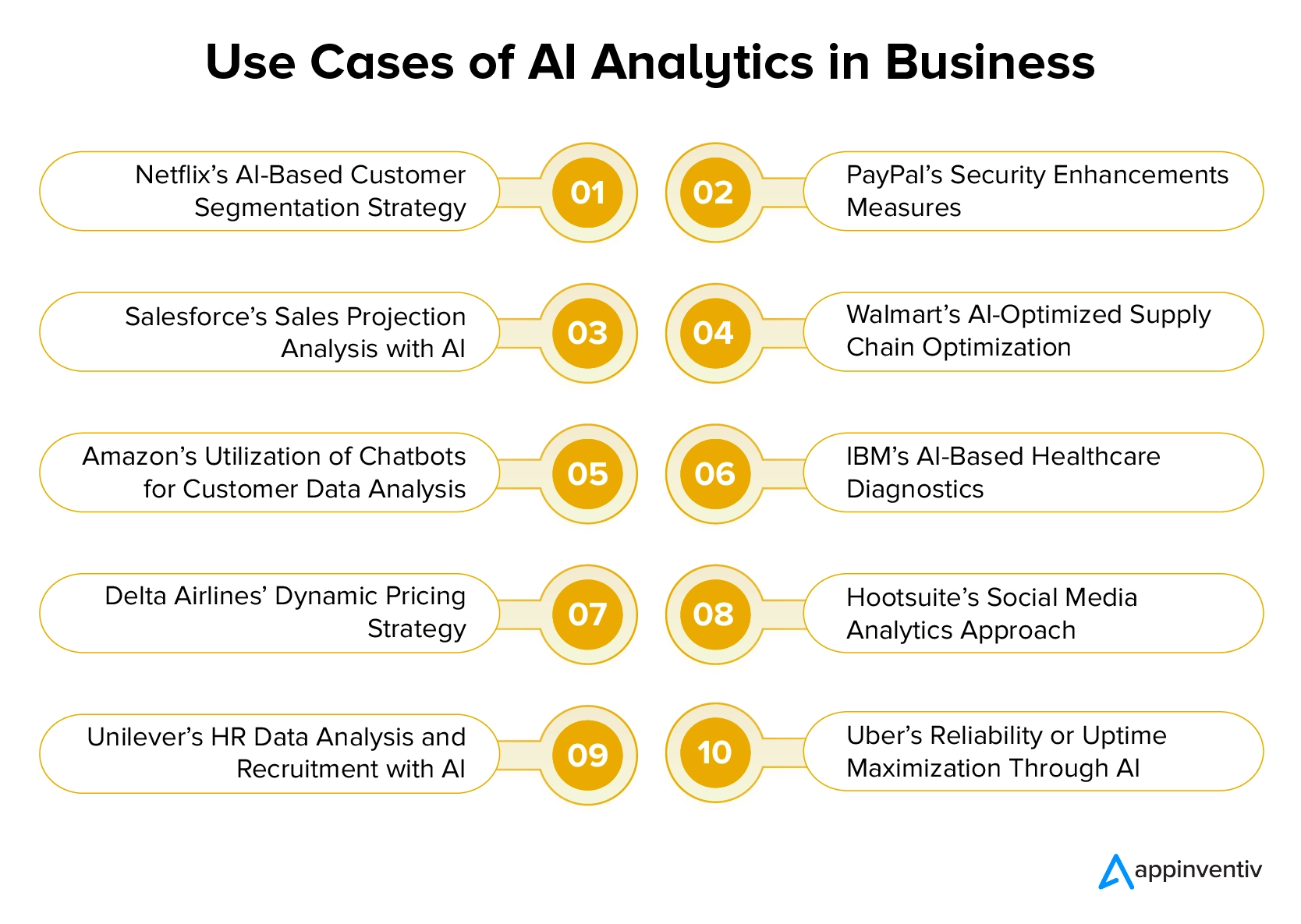
1. Netflix’s AI-Based Customer Segmentation Strategy
Customer segments can be created using AI data according to their demographics, preferences, and behavior. By using segmentation, organizations can improve client satisfaction and retention by providing distinct customer groups with individualized experiences, focused marketing efforts, and product suggestions.
For instance, Netflix divides its user base into various groups using AI analytics to examine user behavior, including viewing history and preferences. This boosts customer satisfaction and engagement by enabling them to offer tailored suggestions for movies and web series.
2. PayPal’s Security Enhancements Measures
Real-time AI analytics in finance can identify patterns of fraudulent activities. Businesses can lessen financial losses and improve the security of financial systems by promptly identifying and stopping fraudulent transactions. This can be done by closely monitoring and comparing them to pre-established patterns.
PayPal, for instance, uses artificial intelligence to recognize and stop fraudulent transactions instantly. PayPal’s AI system examines user behavior, transaction patterns, and other pertinent data through advanced algorithms and machine learning models to promptly identify anomalies or suspicious activity.
It helps PayPal reduce the likelihood of financial fraud with users and the platform by taking prompt action, such as stopping or flagging transactions. In addition to improving the security of financial transactions, the real-time aspect of this AI-driven fraud detection helps retain users’ confidence and trust in PayPal’s services.
At Appinventiv, we worked with Bajaj Finserv, a leading Indian FinTech enterprise, helping them solve their security challenges. We utilized advanced security methods to prevent and predict financial fraud. This helped them increase their merchant onboarding to 300+, ensuring 3 lacs+ transactions per day.
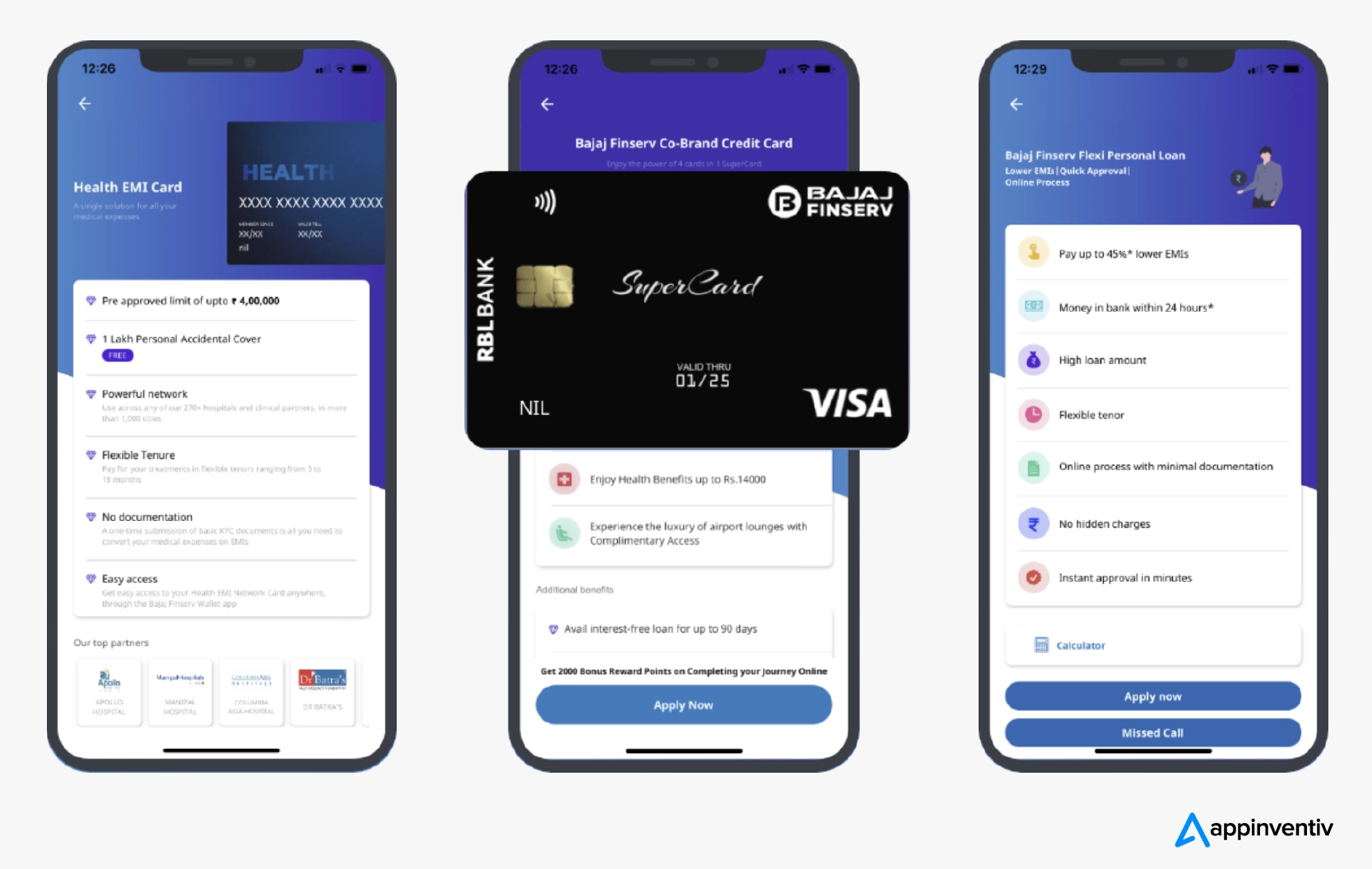
3. Salesforce’s Sales Projection Analysis with AI
Predictive analytics forecasts future sales by utilizing market trends, customer behavior, and past data. This aids companies in resource allocation, marketing strategy planning, and inventory optimization. It lessens the effects of erratic market conditions and helps in quick decision-making.
Salesforce, for instance, uses artificial intelligence-driven data analytics to prioritize leads for sales teams and forecast sales trends. Sales forecasting, pricing optimization, and potential upsell chances are all aided by Salesforce’s Einstein Analytics, which analyzes past data, current market conditions, and customer behavior.
4. Walmart’s AI-Optimized Supply Chain Optimization
AI analytics for businesses helps organizations analyze enormous volumes of data involving logistics, demand, and inventory levels to optimize the supply chain. By using data for a better decision-making process, businesses can optimize transportation routes, change production schedules, and save money while increasing overall efficiency.
For instance, Walmart utilizes the power of AI insights to optimize its supply chain. Through meticulous analysis of inventory levels, product demand, and transportation logistics, Walmart increases operational efficiency and cuts costs. Also, it helps Walmart ensure continuous stocking of products in stores, guaranteeing a streamlined and customer-centric shopping experience.
At Appinventiv, we helped a global manufacturing company enhance its operational efficiency by deploying an efficient supply chain management solution. This resulted in a 60% increase in supply chain visibility, a 30% rise in operational efficiency, and a 40% reduction in transportation costs.
5. Amazon’s Utilization of Chatbots for Customer Data Analysis
Enterprises widely use AI chatbots for customer support services, offering real-time, and round-the-clock client service. In addition to assisting users with troubleshooting procedures and, if necessary, elevating complex issues to human agents, they can respond to commonly asked inquiries through their AI analytics capabilities. This increases the effectiveness of customer care, speeds up response times, and improves the general customer experience.
Amazon, one of the biggest eCommerce technologies, has effectively incorporated AI chatbots into its customer support services, which has also helped them overcome manual data analysis challenges. AI chatbots can analyze data faster than humans, which ensures that customers always get timely assistance. Leveraging AI analytics capabilities, chatbots can analyze consumer behavior and offer users personalized recommendations.
6. IBM’s AI-Based Healthcare Diagnostics
Medical experts can diagnose illnesses and offer personalized treatment options using AI analytics in healthcare. AI systems can offer insightful analysis of a large volume of clinical trial data, patient information, and medical journals. This analysis helps healthcare providers provide more precise and timely care.
For instance, IBM Watson uses AI analytics for Oncology to help oncologists diagnose and treat cancer. Based on the unique illness trait of each patient, Watson can prescribe a specific course of treatment by reviewing clinical trial data, medical literature, and patient information.
Appinventiv has successfully implemented AI in healthcare with projects like YouCOMM, an in-hospital patient communication system. With YouCOMM, patients can communicate in real-time with nurses and other hospital staff. The platform has a user-friendly interface that incorporates voice commands and other manual alternatives like head movements.
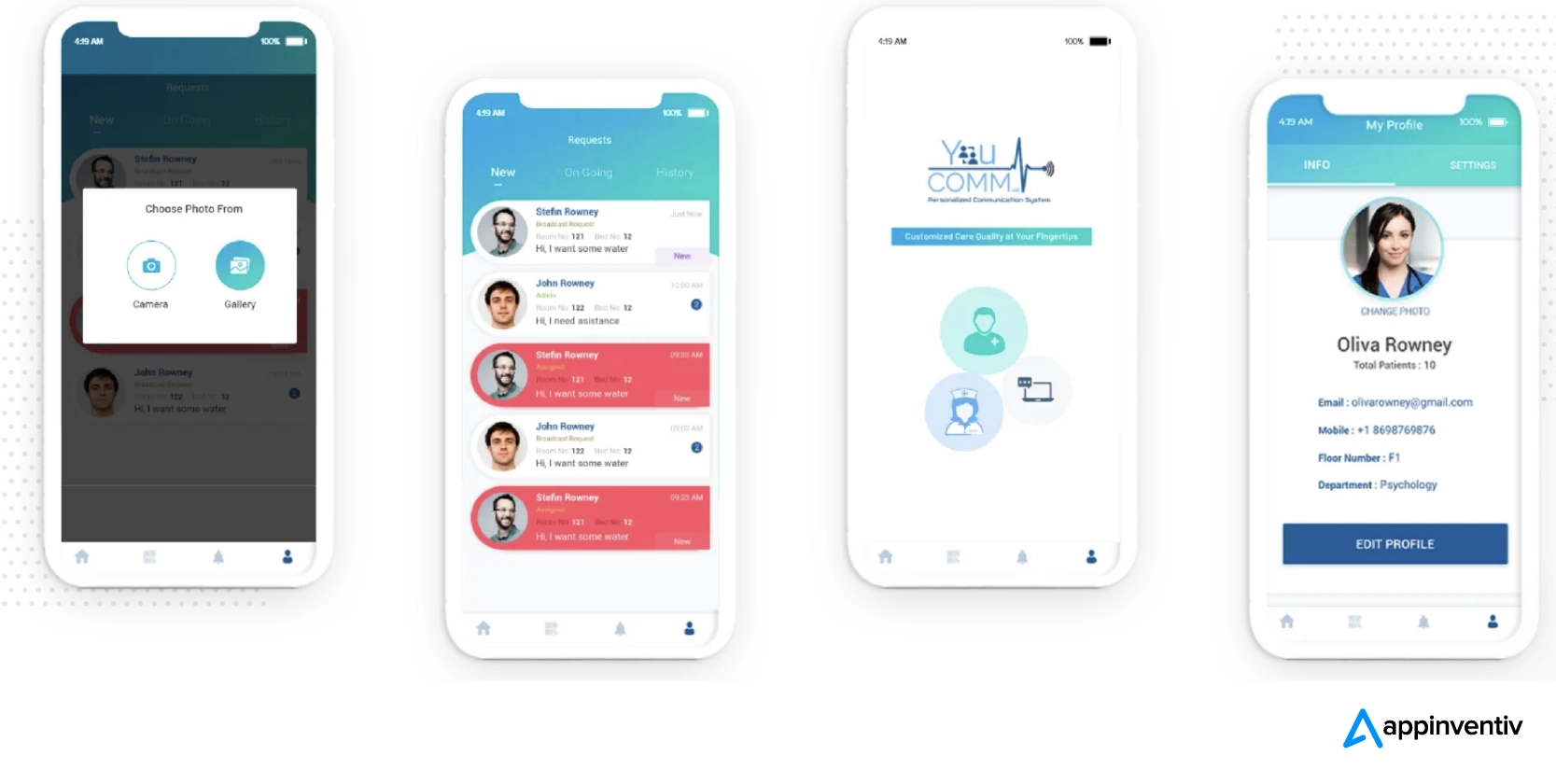
YouCOMM has significantly improved the efficiency of patient-staff contact and allowed hospital administration to maintain thorough records of the timelines with which patients’ requests are completed. The effectiveness of this solution led to its adoption by over 5 hospital chains in the US, resulting in a significant 60% increase in nurses’ real-time response rates.
7. Delta Airlines’ Dynamic Pricing Strategy
Dynamic pricing algorithms analyze competitor pricing, market conditions, and customer behavior to adjust prices in real time. This approach increases revenue by capitalizing on demand variations, providing discounts when demand is low, and optimizing pricing strategies according to various criteria.
Delta Airlines utilizes AI and data analytics to structure its dynamic pricing strategy. The airline can modify ticket rates in real-time to optimize revenue and fill available seats by evaluating the demand, time to departure, and competitor pricing.
8. Hootsuite’s Social Media Analytics Approach
Businesses can better understand their online presence by using AI analytics in social media. Sentiment analysis, for example, determines public opinion on a particular product or brand. These insights help organizations improve engagement, hone their social media strategies, and effectively address client feedback.
For example, Hootsuite uses AI analytics to examine user engagement and social media trends. The platform analyzes sentiment, audience behavior, and the success of social media campaigns using machine learning algorithms.
Also Read: How to Create a Social Media App in 2023 – A Comprehensive Guide
9. Unilever’s HR Data Analysis and Recruitment with AI
AI-powered HR analytics automates applicant matching and resume screening, which expedites the hiring process. This frees HR personnel to concentrate on more strategic hiring tasks like conducting in-depth interviews and determining cultural fit. AI analytics can also aid staff retention by pinpointing the elements influencing job satisfaction.
For example, Unilever uses AI analytics in its hiring process. The business uses AI algorithms to evaluate resumes and find suitable applicants based on their credentials and skill sets. This facilitates the hiring process and helps identify candidates who are best fit for open positions.
10. Uber’s Reliability or Uptime Maximization Through AI
Maintaining uninterrupted operations is more important in a fast-paced world of digital services. Downtime or interruptions can seriously affect organizations trying to fulfill customers’ ever-increasing needs. These consequences can affect customer satisfaction, trust, and the entire company’s reputation.
Uber, a leader in the ride-sharing space, depends on AI to guarantee maximum reliability and uptime. AI systems continuously monitor and analyze enormous databases, seeing possible dangers, inefficiencies, and disruptions in real-time. Uber’s AI-driven analytics method improves platform reliability by proactively addressing issues. In addition to preventing service disruptions, this also lessens the possibility of accidents, hacking, and human error.
Uber’s use of AI in its operations is a prime example of the revolutionary effect on uptime and reliability. It demonstrates how this state-of-the-art technology can improve user experiences and maintain the smooth running of services in the constantly changing digital landscape.
Also Read- AI in Business: A Comprehensive Integration Guide
Navigating Challenges and Considerations in Implementing AI Analytics for Businesses
Implementing artificial intelligence-driven data analytics comes with several complex challenges that can be tackled with proper considerations or solutions. Let’s check those out:
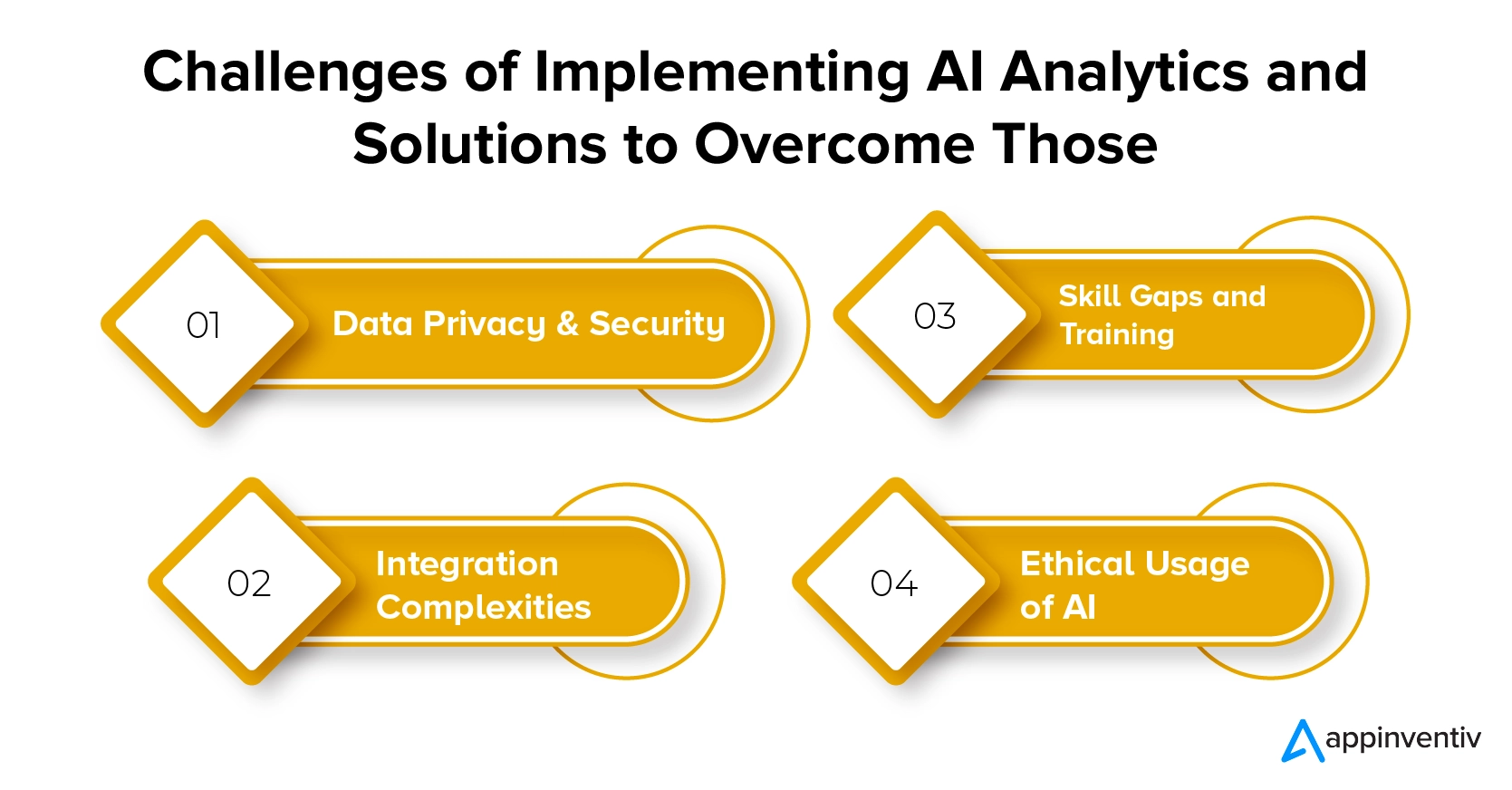
Data Privacy and Security
As data analytics and AI become increasingly significant, concerns about sensitive data security and privacy are growing. The use of enormous datasets presents certain concerns as firms incorporate AI into their operations, such as abuse, unwanted access, and data breaches. The challenge lies in protecting this data from ever-changing cyber threats. Resolving these issues is critical to building trust with stakeholders and users, requiring strong steps to reinforce data privacy and security systems.
Solution: Adopt anonymity strategies, put strong encryption techniques into place, and follow stringent compliance guidelines like GDPR. Frequent evaluations and audits can guarantee data security, and open privacy practices foster user trust.
Integration Complexities
Many intricate components are involved in integrating AI analytics into well-established business processes. Integration challenges arise because firms’ current infrastructures frequently run on multiple platforms and technologies. Compatibility issues, data discrepancies, and disruptions might result from this complexity. These issues must be resolved to fully utilize AI analytics for businesses without interfering with regular operations and to guarantee a smooth and harmonious integration into the organizational structure.
Solution: The best course of action is to invest in interoperability standards, plan for a phased integration strategy, and thoroughly evaluate the current infrastructure. Hiring an experienced software development team ensures a smoother integration process, guaranteeing efficiency in your project.
Skill Gaps and Training
The lack of qualified experts in creating, deploying, and overseeing AI analytics solutions prevents this game-changing technology from being widely used. There is a critical shortage of specialized AI talents since demand exceeds the available talent pool. This challenge affects people in various fields, including data scientists and AI developers.
Solution: Invest in extensive training programs to help current employees become more proficient with AI. Establish partnerships with educational institutions to develop a talent pool for artificial intelligence. Additionally, consider working with AI providers or utilizing managed IT services to compensate for talent gaps and guarantee businesses’ successful adoption of AI analytics.
Ethical Usage of AI
Handling the intricacies of bias, transparency, and potential misuse is necessary to ensure the ethical deployment of AI. Creating algorithms and models that are ethically sound and devoid of biases is the challenging part.
Solution: Ensure AI development teams conduct regular audits of algorithms for bias and foster continuous discussions on ethical AI practices inside the company and across the industry.
Embrace AI-Powered Analytics for Your Business with Appinventiv
AI analytics for businesses is changing industries and operational paradigms in various areas, including manufacturing, retail, healthcare, finance, and marketing. Innovative artificial intelligence business ideas for startups harness the power of artificial intelligence to revolutionize industries. Leveraging AI in business analytics can help in better decision-making processes, predict future trends, uncover hidden insights, automate complex data analysis, and analyze various data sources.
Unlock the power of sophisticated analytics, improve decision-making, and grow your business skills with Appinventiv’s AI analytics services. Our customized AI services are made to push your business toward steady expansion and guarantee a forward-thinking strategy for realizing the full potential of AI in achieving success.
Whether it’s predicting market trends, personalizing customer experiences, or enhancing operational efficiency, our artificial intelligence development services are crafted to meet the unique needs of your business.
Explore the transformative realm of AI analytics for businesses by connecting with our experts today.
FAQs
Q. How is AI analytics used for businesses?
A. Businesses across different sectors utilize AI analytics to enhance decision-making processes, extract valuable insights, and optimize operations. The use of AI analytics for businesses is reflected in these examples:
- Data processing and analysis
- Quality control
- Supply chain optimization
- Employee productivity
- Predictive analytics
- Personalization
- Fraud detection
- Competitive analysis
- Risk management
Q. What is the future of AI analytics for businesses?
A. The future of AI in business is expected to continue to advance toward more complex and personalized insights. Businesses can expect enhanced predictive capabilities as AI technologies develop, offering greater insights into consumer behavior, market trends, and possible hazards. The widespread adoption of automation and increased efficiency will permeate various sectors, integrating AI insights into daily decision-making processes.
AI’s influence will increase when combined with other cutting-edge technologies like edge computing and the Internet of Things (IoT). The increasing prominence of ethical considerations and responsible AI techniques will ensure the appropriate and transparent use of data. Overall, AI analytics will become an invaluable asset for businesses in the coming years, fostering innovation and industry competitiveness.
Q. What is the role of AI analytics in a business?
A. AI analytics offers a transformational impact on the decision-making processes and other pivotal operations of businesses. By leveraging AI algorithms, businesses can attract valuable insights from huge datasets that help them enhance overall efficiency.
AI-powered analytics for business help improve the resource allocation processes, facilitate personalized customer experiences, and reduce costs by identifying the inefficiencies within the organization. It also helps businesses remain agile and responsive in the ever-changing market dynamics. Overall, it helps organizations in navigating complex business challenges.
Business
The “Boring” AI Business Model Making Millionaires in 2025

In 2025, while the world gushed about flashy robots, talking cars, and futuristic gadgets, a group of young people quietly built an AI business so unremarkable at first glance that almost nobody noticed it. It wasn’t glamorous, it didn’t have a viral video, and it didn’t try to predict the next big trend. But it was making millionaires out of regular people… people who had nothing but grit, curiosity, and patience.
This is the story of Maya and her “boring” AI model, and how it reshaped not only her life but the lives of thousands who followed her blueprint.
Maya was 27 in early 2024, living in a one-bedroom apartment above a grocery store in a crowded city. She had a degree in literature, not engineering, and worked as a night-shift clerk in a local print shop.
She had no investors, no startup culture contacts, and no idea how to code beyond simple website builders. But she had two assets few people had: relentless curiosity and the habit of looking for problems that nobody wanted to solve.
One evening, while scrolling through forums about small business challenges, she noticed dozens of owners complaining about repetitive, mundane tasks: sorting invoices, tagging emails, filing customer questions, and moving data from one platform to another. It wasn’t glamorous work. It wasn’t on the cover of magazines. But it was expensive and time-consuming.
And something clicked.
“What if AI could quietly do all these boring tasks?” she wondered.
While the tech world chased billion-dollar breakthroughs in self-driving cars and virtual universes, Maya started tinkering with the “unsexy” side of artificial intelligence. She didn’t try to build a sentient assistant. Instead, she built small, focused AI “micro-tools” that automated the ugly, tedious back-office work of everyday businesses.
Maya’s first tool wasn’t impressive. It was a simple AI model that read PDF invoices, extracted key data, and entered it into spreadsheets for small business owners. She found an open-source language model online, watched tutorials for weeks, and cobbled together an interface using no-code platforms. She spent nights testing it on free samples and begging café owners to try it.
Her first paying client was a family-run furniture shop. They hated doing paperwork at the end of every week. Maya’s tool reduced their 6-hour weekly process to 30 minutes. They paid her $50 a month. She danced around her apartment with joy.
But Maya didn’t stop. She built a second micro-tool to categorize customer emails into urgency levels. A third to predict low inventory items. Each small AI bot solved one tiny, boring problem. Together, they saved small businesses hundreds of hours.
By mid-2024, Maya had 47 clients paying $30-$200 a month. Not life-changing, but enough to quit her print shop job. She then created subscription tiers and white-labeled her micro-tools so other freelancers could sell them too. Her pitch wasn’t sexy; it was practical. “Save time. Save money. Grow quietly.”
This was the turning point.
A former schoolteacher named Daniel, 32, bought a license to resell Maya’s AI bots in his own city. He signed up 20 businesses in a month. He made more than he’d made teaching full-time. A retired accountant named Lucia, 58, did the same. She introduced the tools to her network of small retailers and built a six-figure income in a year.
The “boring” AI model had become a movement… not of tech moguls, but of ordinary people solving ordinary problems.
Maya’s philosophy was simple:
Don’t chase hype.
Solve persistent problems.
Keep costs low and margins healthy.
Let others partner and profit.
Instead of selling one giant software platform, she sold dozens of tiny, niche AI “workers” that anyone could subscribe to individually. This modular approach allowed even small-town businesses to adopt AI at their own pace.
By early 2025, hundreds of resellers around the world were using Maya’s framework to deliver micro-AI services. Some ran one-person operations; others built small agencies. They weren’t Silicon Valley founders… they were baristas, teachers, retirees, and college kids who saw a need and used Maya’s blueprint.
One such story was Sophie, a 21-year-old student who had grown up watching her parents run a bakery. Sophie bought Maya’s AI invoicing and scheduling tools, customized them with her own branding, and started selling them to bakeries and cafés in her region. Within six months, she’d replaced her part-time job income. Within a year, she was making $12,000 a month… enough to pay off her student loans before graduating.
Then there was Amir, 44, a former mechanic who lost his job during an economic downturn. He learned how to use Maya’s training materials, packaged AI bots for auto shops, and made more money in his first year of self-employment than he ever had before.
The model worked because it wasn’t glamorous. No flashy ads. No wild claims. Just steady value. Maya called it “AI plumbing”… building the pipes that let small businesses run smoother.
She focused on four principles:
1. Accessibility: Make it cheap and easy enough for non-tech people.
2. Education: Offer plain-language training and support.
3. Flexibility: Let resellers white-label and adjust pricing.
4. Community: Encourage sharing improvements and templates.
By mid-2025, Maya herself wasn’t just running a business. She was leading a decentralized movement of AI micro-entrepreneurs. Her own income grew into the millions, but she always reinvested in building better training and tools.
And yet Maya stayed humble. She still lived in a modest apartment, still answered customer support emails personally, and still said no to investors who wanted to “scale aggressively.” She believed the real revolution wasn’t another billion-dollar tech giant but thousands of small, empowered entrepreneurs earning honest incomes from useful AI tools.
Her success attracted skepticism. Some said it was too simple. Others thought the big companies would crush her. But Maya knew she was in a different lane. She wasn’t trying to win a popularity contest… she was trying to solve real problems.
And as the economy shifted in 2025, her approach turned out to be exactly what people needed: stability, low overhead, and the ability to start small.
By late 2025, analysts began to notice. Articles described the phenomenon of “boring AI” making quiet millionaires. But those inside the movement already knew: it wasn’t about hype. It was about mindset.
Maya often told her community:
“Find a problem. Build the simplest AI solution. Offer it to the people who need it most. Repeat. Don’t try to impress. Try to improve.”
It was a model anyone could adopt. A 19-year-old in Manila built AI tools for local fishermen to predict tide patterns. A 63-year-old in Nairobi used AI bots to help farmers monitor soil moisture. A single mom in Toronto built an AI appointment scheduler for local hair salons. The stories poured in, all rooted in the same principle: simple solutions, consistent effort, and community sharing.
Maya had proven something profound:
You don’t need to invent the next flying car to become successful. You can build “boring” tools that make life easier… and people will pay for that forever.
Moral of the Story
In a world obsessed with hype and spectacle, quiet consistency and practical problem-solving can outlast trends. The “boring” AI business model shows that success isn’t about dazzling innovation… it’s about meaningful impact. When you stop chasing fame and start solving real problems, you unlock a sustainable path to wealth, freedom, and purpose. Even the most ordinary ideas, applied persistently, can change lives… including your own.
Business
The AI Movie Factory Is Ramping Up

“Because I know the rooster.”
Those were the words of a Baghdad-based director named Hasan Hadi when asked how he was able to corral not just a host of non-actor children for his new movie but a particular kind of junglefowl.
Hadi – his The President’s Cake will come out this fall from Sony Pictures Classics and was just chosen as the official Iraqi Oscar submission – made the comment to a pair of reporters at a dinner at the Toronto International Film Festival. While among the more colorful – and barnyardy – of the remarks uttered at the important early-September gathering, it was far from the only one emphasizing the uniquely human qualities of filmmaking.
Across the Canadian city, directors made statements that, as the algorithm rises, almost take on a political cast. Richard Linklater and Ethan Hawke stood in front of an audience and described the painstaking rehearsal for their movie about Lorenz Hart. (“Ethan and I have done our share of dialogue-ntensive movies,” Linklater said, “but this was something else.”) Nia DaCosta talked about how her feelings on Ibsen animated her need to redo Hedda Gabler. Paul Greengrass left audiences breathless with his latest neo-verite adventure that has Matthew McConaughey as an embattled bus driver saving children in the 2018 Paradise wildfires.
None of them mentioned AI explicitly. They didn’t have to. Their pro-human vehemence was evident in every quote and frame.
But a different vision of Hollywood was also playing out at the industry’s big convocation, as tech entrepreneurs pitched their own vision to the entertainment decisionmakers. People from Largo, which builds models to test movies using virtual audiences. Luma AI, whose executives think studios can deploy their video-generation tool to ramp up production (and ramp down sets). Genny, which uses Google’s VEO-3 to help documentarians create re-enactment footage with the push of a button. All of them were at TIFF too, trying to enact their own vision of the entertainment future. And while they rarely crossed paths with the humanists, they clashed with them ideologically just the same. Hollywood may only be big enough for one them.
Pull the camera back and you’ll suddenly see the same battle playing out everywhere, in boardrooms and courtrooms. Warner Bros. has just sued Midjourney, making similar allegations as Disney and Universal before it against the image-generation startup. Anthropic has just agreed to settle with three authors who sued the AI company for training its models on their books. If the settlement is approved, it could result in the company paying a total of $1.5 billion to hundreds of thousands of authors – but the judge in the case also cleared the way for tech companies to engage in such training without permission so long as they bought retail copies of the books.
Seeking to convey the stakes, two activists, Guido Reichstadter and Michael Trazzi, have gone on hunger strikes outside the San Francisco office of Anthropic and London office of Google’s DeepMind respectively. They say they won’t eat any food until the companies stop developing all new AI models, giving both a visual and historical dimension to the conflict.
Meanwhile, the startup Showrunner, with investment from Amazon, made waves when it said it would use AI for an internal experiment to restore some 43 minutes of lost footage from Orson Welles’ The Magnificent Ambersons. The announcement generated a backlash from the company managing Welles’ estate, which an official there calling the move a “purely mechanical exercise” that lacked “uniquely innovative thinking.”
And of course The Sphere just opened an AI-enabled re-formatted The Wizard of Oz, aided by Google and $80 million (a budget $15 million higher than the original’s in 2025 dollars). While eliciting rave reviews, the project also added in cameos for the CEOs David Zaslav and James Dolan who were not, according to most film historians, present on the 1939 MGM set.
After years of companies building tech and raising money, the introduction of AI into the house of storytelling is finally here. And media players need to decide whether they want to make up the guest bedroom.
It would also be a mistake to think AI will only be used on classic films – on films with few stakeholders. The tools pitched and implemented would be used to create what was once done by hand on sets and in marketing departments, automating the analogue, with all the labor and cultural consequences to go with it.
At a hearing for the Anthropic settlement, one of the author plaintiffs, Kirk Wallace Johnson, said he saw the proceeding as the “beginning of a fight on behalf of humans that don’t believe we have to sacrifice everything on the altar of AI.” Johnson is the author of The Feather Thief, a critically acclaimed 2018 true-crime book about a heist that made off with scores of centuries-old historical bird skins. You could say that he, too, knows the rooster.
This story appeared in the Sept. 10 issue of The Hollywood Reporter magazine. Click here to subscribe.
Business
How To Un-Botch Predictive AI: Business Metrics

Data scientists consider business metrics more important than technical metrics – yet in practice they focus more on technical ones. This derails most projects. So, why?
Eric Siegel
Predictive AI offers tremendous potential – but it has a notoriously poor track record. Outside Big Tech and a handful of other leading companies, most initiatives fail to deploy, never realizing value. Why? Data professionals aren’t equipped to sell deployment to the business. The technical performance metrics they typically report on do not align with business goals – and mean nothing to decision makers.
For stakeholders and data scientists alike to plan, sell and greenlight predictive AI deployment, they must establish and maximize the value of each machine learning model in terms of business outcomes like profit, savings – or any KPI. Only by measuring value can the project actually pursue value. And only by getting business and data professionals onto the same value-oriented page can the initiative move forward and deploy.
Why Business Metrics Are So Rare for AI Projects
Given their importance, why are business metrics so rare? Research has shown that data scientists know better, but generally don’t abide: They rank business metrics as most important, but in practice focus more on technical metrics. Why do they usually skip past such a critical step – calculating the potential business value – much to the demise of their own projects?
That’s a damn good question.
The industry isn’t stuck in this rut for only psychological and cultural reasons – although those are contributing factors. After all, it’s gauche and so “on the nose” to talk money. Data professions feel compelled to stick with the traditional technical metrics that exercise and demonstrate their expertise. It’s not only that this makes them sound smarter – with jargon being a common way for any field to defend its own existence and salaries. There’s also a common but misguided belief that non-quants are incapable of truly understanding quantitative reports of predictive performance and would only be misled by reports meant to speak in their straightforward business language.
But if those were the only reasons, the “cultural inertia” would have succumbed years ago, given the enormous business win when ML models do successfully deploy.
The Credibility Challenge: Business Assumptions
Instead, the biggest reason is this: Any forecast of business value faces a credibility question because it must be based on certain assumptions. Estimating the value that a model would capture in deployment isn’t enough. The calculation has still got to prove its trustworthiness, because it depends on business factors that are subject to change or uncertainty, such as:
- The monetary loss for each false positive, such as when a model flags a legitimate transaction as fraudulent. With credit card transactions, for example, this can cost around $100.
- The monetary loss for each false negative, such as when a model fails to flag a fraudulent transaction. With credit card transactions, for example, this can cost the amount of the transaction.
- Factors that influence the above two costs. For example, with credit card fraud detection, the cost for each undetected fraudulent transaction might be lessened if the bank has fraud insurance or if the bank’s enforcement activities recoup some fraud losses downstream. In that case, the cost of each FN might be only 80% or 90% of the transaction size. That percentage has wiggle room when estimating a model’s deployed value.
- The decision boundary, that is, the percentage of cases to be targeted. For example, should the top 1.5% transactions that the model considers most likely to be fraudulent be blocked, or the top 2.5%? That percentage is the decision boundary (which in turn determines the decision threshold). Although this setting tends to receive little attention, it often makes a greater impact on project value than improvements to the model or data. Its setting is a business decision driven by business stakeholders, representing a fundamental that defines precisely how a model will be used in deployment. By turning this knob, the business can strike a balance in the tradeoff between a model’s primary bottom-line/monetary value and the number of false positives and false negatives, as well as other KPIs.
Establishing The Credibility of Forecasts Despite Uncertainty
The next step is to make an existential decision: Do you avoid forecasting the business value of ML value altogether? This would prevent the opening of a can of worms. Or do you recognize ML valuation as a challenge that must be addressed, given the dire need to calculate the potential upside of ML deployment in order to achieve it? If it isn’t already obvious, my vote is for the latter.
To address this credibility question and establish trust, the impact of uncertainty must be accounted for. Try out different values at the extreme ends of the uncertainty range. Interact in that way with the data and the reports. Find out how much the uncertainty matters and whether it must somehow be narrowed in order to establish a clear case for deployment. Only with insight and intuition into how much of a difference these factors make can your project establish a credible forecast of its potential business value – and thereby reliably achieve deployment.
-

 Business2 weeks ago
Business2 weeks agoThe Guardian view on Trump and the Fed: independence is no substitute for accountability | Editorial
-
Tools & Platforms4 weeks ago
Building Trust in Military AI Starts with Opening the Black Box – War on the Rocks
-

 Ethics & Policy1 month ago
Ethics & Policy1 month agoSDAIA Supports Saudi Arabia’s Leadership in Shaping Global AI Ethics, Policy, and Research – وكالة الأنباء السعودية
-

 Events & Conferences4 months ago
Events & Conferences4 months agoJourney to 1000 models: Scaling Instagram’s recommendation system
-

 Jobs & Careers2 months ago
Jobs & Careers2 months agoMumbai-based Perplexity Alternative Has 60k+ Users Without Funding
-

 Education2 months ago
Education2 months agoVEX Robotics launches AI-powered classroom robotics system
-

 Podcasts & Talks2 months ago
Podcasts & Talks2 months agoHappy 4th of July! 🎆 Made with Veo 3 in Gemini
-

 Education2 months ago
Education2 months agoMacron says UK and France have duty to tackle illegal migration ‘with humanity, solidarity and firmness’ – UK politics live | Politics
-

 Funding & Business2 months ago
Funding & Business2 months agoKayak and Expedia race to build AI travel agents that turn social posts into itineraries
-

 Podcasts & Talks2 months ago
Podcasts & Talks2 months agoOpenAI 🤝 @teamganassi



